|
San Francisco Ballet opened its 2016 season with two top choreographers of the day. “Pas/Parts” (Program 1) is an American premiere by the grand-master of contemporary ballet, William Forsythe. Program 2 offers a World premiere by young British master Liam Scarlett, titled “Fearful Symmetries.”
Obsessive Steps: “Pas/Parts” by William Forsythe
Forsythe founded his own “Frankfurt Ballet” in 1984, and now co-directs the Paris Opera Ballet, where he created
“Pas/Parts” in 1999. San Francisco Ballet’s director Helgi Tomasson wanted the work right away but had to wait because Forsythe felt a need to edit a bit
before sharing the piece with another company.
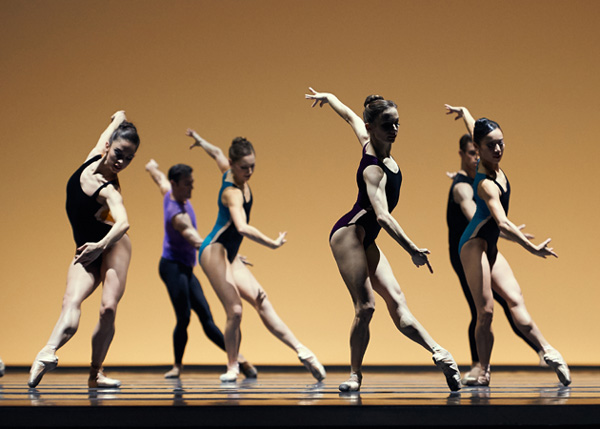
“Pas/Parts” seems to have lost some excitement since 1999, and
the back to back comparison with Scarlett’s new creation didn’t exactly help the piece. Forsythe’s abstract work used to provide
considerable thrill – a strict, classical baseline, dissected and deconstructed with sometimes Balanchinian inventiveness and
precision (his 1984/2004 masterpiece “Artefact Suite,” was reviewed in these pages*). Extreme twists and breath-taking off
-balance “combat” pas de deux; devilish speed; large groups mixing principal and corps dancers to great effect.
“Pas/Parts” only serves “parts” of the choreographer’s palette.
No combat couples, no trace of witty play with and against Balanchine, no individuality in the dancers who seem altogether abstracted into steps (Pas) and body-parts (Parts). When not
even Yuan Yuan Tan, SF Ballet’s leading ballerina with her extraordinary feet and extension, manages to stand out in the mass of flailing limbs, you have to wonder.
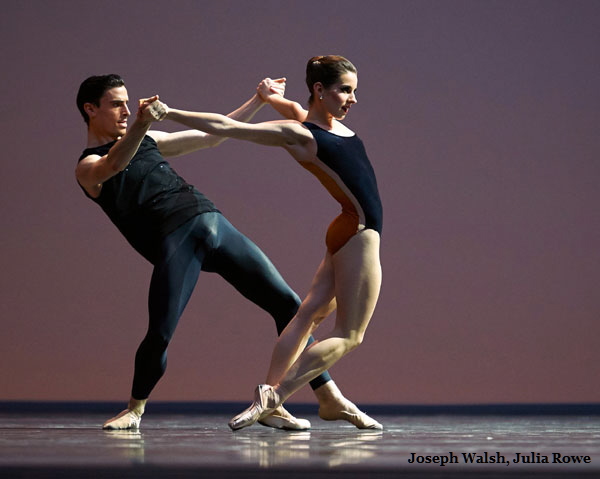
Watching rehearsal videos on the SF Ballet website, Forsythe’s steps look intricate and interesting in their detail, but on the
whole, seem to run on empty. A dead-beat electronic composition by Thom Willems (an old-time favorite of Forsythe)
is almost devoid of danceable rhythms. The “amorphous score” (Forsythe) forces the dancers to bite the bullet and invent
rhythms, timing, structure in and through their bodies. They do so with grim determination, throwing and tossing limbs as hard
and fast as they can against the musical void and against the classical grain: any limb usually turned out is turned in, any leg
thrown up straight is bent at the knee, any shoulder turn radically opposes the hips, etc. Counterpoint reigns as
Forsythe’s favorite, obsessive principle, executed admirably by the company. But this time no dance ensues.
Of course it’s easy to see the thought and structural calculation
in the rapid changes of choreographic “parts”: solos, duos, trios, small groups forming and dissolving onstage. There is not a
trace of the chaos and helpless mess that inexperienced choreographers tend to create with big ensembles. Repetitive, controlled but frenzied boredom is what you get with
“Pas/Parts,” boxed into a walled-in, glumly lit stage.
Luckily there are a couple of moments where the composer concedes to a few bars of rhythmic beat and Forsythe follows
suit: A small group rises from the ensemble to follow the beat in synchronized leaps and bounds: in an instant, life springs up
onstage, and one sighs with relief. Suddenly, for a moment, there’s dance, beauty, meaning.
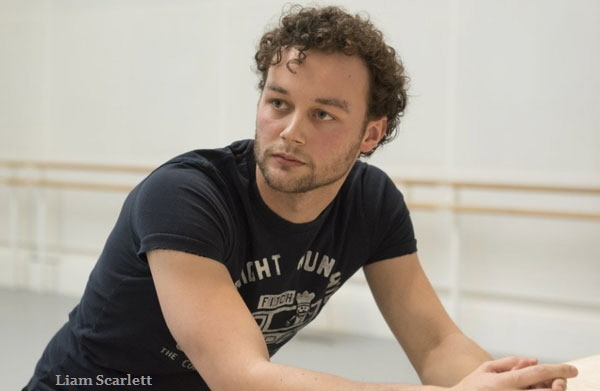
“The Tyger” pounces:
Liam Scarlett’s Fearful Symmetries
Liam Scarlett’s new creation couldn’t be more different. Life,
youth, passion, sex, humor bounce off the stage, fulfilling the promise of the Royal Ballet’s choreographer’s first creation for
San Francisco Ballet, “Hummingbird” (reviewed in these pages**) set to a throbbing score by Philip Glass. This time it’s an equally
exciting, throbbing piece by John Adams, forward-driving like a night train. Adams calls his “Fearful Symmetries” “traveling
music, music that gives the impression of continuous movement over a shifting landscape.” The piece has been choreographed a
number of times (by Peter Martins, for example), and no wonder: the moods of the trip are rich and colorful, evoking film
noir suspense, Blues melancholy, and youthful, West Side Story-like punch (beautifully performed by the San Francisco Ballet Orchestra under Martin West).
What is immediately striking is the visible joy and enthusiasm of all 16 dancers in this new creation. Scarlett’s choreographic
language is an emotionally infused amalgam of classical, jazzy, modern, Broadway, Hip Hop, and Bump and Grind, with high
technical and acrobatic demands that the company seems to toss off with a smile.
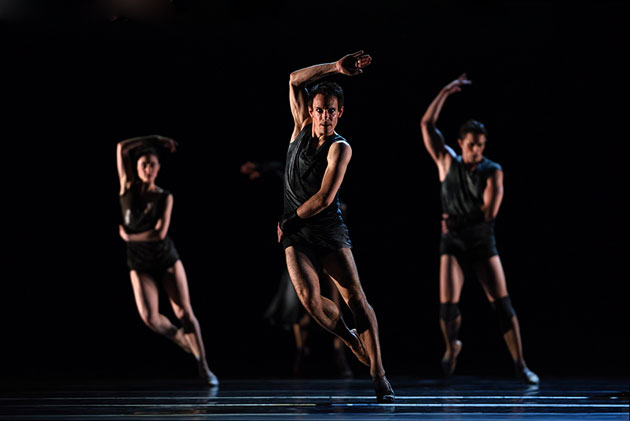
Scarlett’s rendition of the “fiendishliy difficult” piece makes the
most of John Adam’s theme: William Blake’s poem “The Tyger” with its famous lines, “What immortal hand or eye/ Could frame
thy fearful symmetry.” Feline velocity is delivered with a nonchalant permission to let the body be natural and relaxed,
even odd or off-position. Tension explodes with a pounce in shifts of motion, lifts, spins, shoulders rolling, hips rotating,
arms and fists pumping. There is a moment when the stomping rhythm calls up the visceral threat of nature in Stravinsky’s “Rite of Spring.”
The women this time are without point shoes: the choreographer wanted to see them as “gender-ambiguous” and
“more part of a pack.” Everyone (except one skirted dancer) is in black, stretchy-silky leotards, appearing and disappearing from
a black back-drop as if from a dark jungle night. The night turns contemporary with white neon bars lighting up in different
geometrical patterns, but this night still keeps the dancers in the shade, so to speak, insisting on its mysteries.
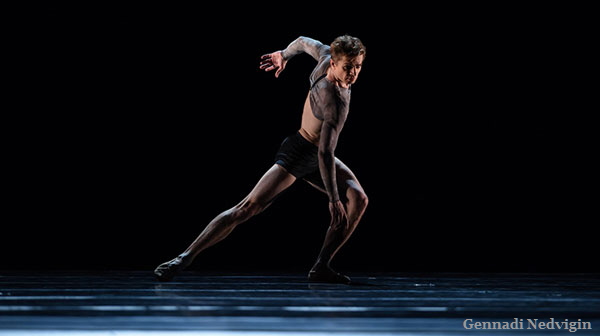
A stark solo brings out principal Gennadi Nedvigin’s muscular prowess, but his costume oddly throttles him with a short
-cropped, lacy top that creeps up around his throat and neck, distracting almost like a “wardrobe malfunction.” An intense,
sexy passage takes one couple out of the “pack”: Lorena Feijoo (in the skirt) and Luke Ingham dance a seduction scene that
could be called “full frontal impact,” and Feijoo is at her best as a sinuous, hot, commanding femme fatale.
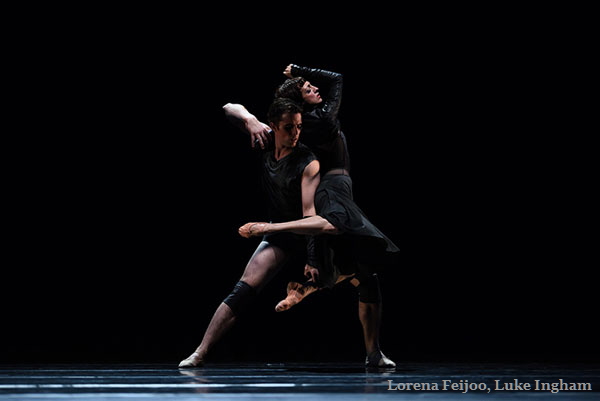
At the end, the pleasure ride of pulsing music and feral velocity suddenly turns quiet. A couple in soft white, Yuan Yuan Tan and
Pascal Molat, dance a serene, enigmatic pas de deux that seems to gaze back at the classical canon. Tan’s extraordinary feet and
legs (featured here to full effect) and her exquisite grace seem to evoke the spiritual yearning of Blake’s poem, the wise and
somewhat sad recognition that we can’t “frame” or apprehend the grand scheme—the “fearful symmetries,” of creation. It is a
tender, lyrical, questioning ending.
Scarlett is working on a new co-production between the Royal Ballet and San Francisco Ballet: an evening-length
“Frankenstein.” Something to look forward to next year.
Footnotes
* http://www.scene4.com/archivesqv6/apr
-2007/html/renatestendhal0407.html
**http://www.scene4.com/archivesqv6/2015/may
-2015/0515/renatestendhal0515.html
Photos —Erik Tomasson
|